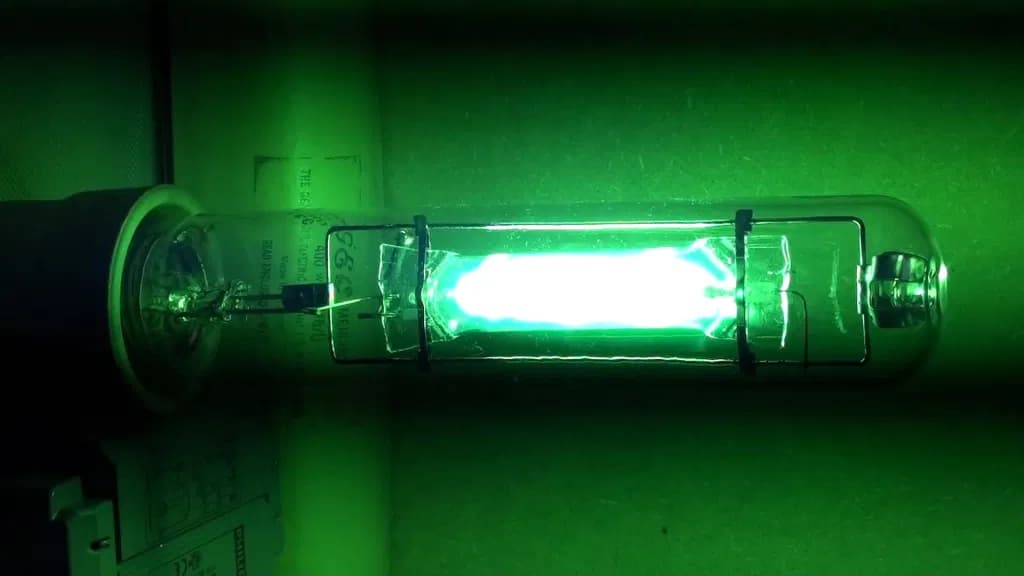
A mercury-vapor lamp is a gas discharge lamp that uses mercury in an excited state to produce light. The arc discharge is generally confined to a small fused quartz arc tube mounted within a larger borosilicate glass bulb. The outer bulb may be clear or coated with a phosphor; in either case, the outer bulb provides thermal insulation, protection from ultraviolet radiation, and a convenient mounting for the fused quartz arc tube.
Mercury vapor lamps (and their relatives) are often used because they are relatively efficient. Phosphor coated bulbs offer better color rendition than either high- or low-pressure sodium vapor lamps. Mercury vapor lamps also offer a very long lifetime, as well as intense lighting for several special purpose applications.
Theory and relations:
The mercury vapor lamp is a negative resistance device and requires a ballast to prevent it from taking excessive current. The auxiliary components are substantially similar to the ballasts used with fluorescent lamps. In fact, the first British fluorescent lamps were designed to operate from 80-watt mercury vapor ballasts.
Also like fluorescent lamps, mercury vapor lamps usually require a starter, which is usually contained within the mercury vapor lamp itself. A third electrode is mounted near one of the main electrodes and connected through a resistor to the other main electrode. When power is applied, there is sufficient voltage to strike an arc between the starting electrode and the adjacent main electrode. This arc discharge eventually provides enough ionized mercury to strike an arc between the main electrodes. Occasionally, a thermal switch will also be installed to short the starting electrode to the adjacent main electrode, completely suppressing the starting arc once the main arc strikes.
Variation: Metal halide:
A closely-related lamp design called the metal halide lamp uses various compounds in an amalgam with the mercury. Sodium iodide and Scandium iodide are commonly in use. These lamps can produce much better quality light without resorting to phosphors. If they use a starting electrode, there is always a thermal shorting switch to eliminate any electrical potential between the main electrode and the starting electrode once the lamp is lit. (This electrical potential in the presence of the halides can cause the failure of the glass/metal seal). More modern metal halide systems do not use a separate starting electrode; instead, the lamp is started using high voltage pulses as with high-pressure sodium vapor lamps. “MetalArc” is Osram Sylvania’s trademark for their metal halide lamps; “Arcstream” and “MultiVapor” are General Electric’s trademark. Besides their use in traditional outdoor lighting, these lamps now appear in most computer and video projectors. However, Philips’ UHP lamp, introduced in 1995, contains only mercury. As an example of application and efficiency of mercury lamps, the 61″ Samsung DLP rear projection TV (HL-S6187W) uses a 132-watt Philips UHP lamp.
Self-ballasted (SB) lamps
There are mercury vapor lamps with a filament inside connected in series with the arc tube that functions as an electrical ballast. This is the only kind of mercury vapor lamp that should be connected directly to the mains without an external ballast. These lamps have only the same or slightly higher efficiency than incandescent lamps of similar size, but have a longer life. They give light immediately on startup, but usually needs a few minutes to restrike if power has been interrupted. Because of the light emitted by the filament, they have slightly better color rendering properties than mercury vapor lamps. The color temperature is higher than incandescent lamps.
**This technology is being phased out across the United States and eventually is planned to be phased out completely under the Federal Energy Independence and Security Act of 2007.
How Can We Help?
Industrial Light and Power is here to answer any questions that you may have. We take pride in our adaptability and service so if you don’t see something you’re looking for feel free to ask us about it.





